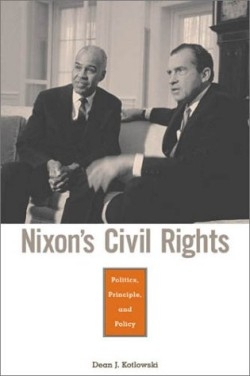Nixon's Civil Rights
Politics Principle and Policy
Civil rights leaders of the 1960s and ‘70s did not
regard Richard Nixon highly for his support of the movement; yet the president’s promotion of affirmative action and funding for minority-owned businesses and historically black colleges set precedents that continue to have positive impacts on the lives of minorities today. The author, a member of the history department of Salisbury State University, presents an important investigation of Nixon’s civil rights policies for African-Americans, Native Americans, and women.
Although Nixon supported all voting and civil rights bills when he served as Dwight Eisenhower’s vice president during the 1950s and into the late ‘60s, when he became president he encountered frosty relations with African-Americans because he opposed integration and busing, while refusing to make a major speech showing his support of civil rights. Instead, Nixon’s policies were “flexible and opportunistic,” and sought a middle path between the demands of segregationists like George Wallace and liberals such as Hubert Humphrey and George McGovern. Nixon sponsored new programs targeting minority businesses and education, which he hoped would lead to an expanded, Republican black middle class. The president attempted to move the focus of civil rights away from integration—which typically meant building housing projects scattered throughout the suburbs—and toward minority economic development, which would not alienate his voting base of Southerners and Northern ethnic groups.
President Nixon’s civil rights policies for Native Americans were more successful, although his programs largely ignored more militant urban-living Native Americans, who accounted for fifty percent of the 800,000 total population. Nixon is credited for progressive programs that reversed the longtime trend of forcing Native Americans to assimilate into white society. This, however, was not enough for Russell Means, leader of the radical American Indian Movement, which regarded the Bureau of Indian Affairs as a bureaucratic extension of American colonialism.
The growing Women’s Right Movement received less support from the Nixon administration. The president, during a sexist, male-dominated era, refused to support the Equal Rights Amendment, believing that the Equal Pay Act of 1963 and Title VII of the 1964 Civil Rights Act were sufficient protectors of equal opportunity.
Kotlowski has written an important, comprehensive appraisal of Richard Nixon’s civil rights policies. He demonstrates that although these programs will not create an enduring legacy for the late president, Nixon enjoyed some success in breaking down racial barriers in industry, if not in neighborhoods and schools.
Reviewed by
Karl Helicher
Disclosure: This article is not an endorsement, but a review. The publisher of this book provided free copies of the book to have their book reviewed by a professional reviewer. No fee was paid by the publisher for this review. Foreword Reviews only recommends books that we love. Foreword Magazine, Inc. is disclosing this in accordance with the Federal Trade Commission’s 16 CFR, Part 255.

